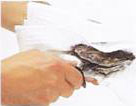|
|
|
FISH STOCK
Ask at the Jish store Jar heads, bones, and trimmings Jrom lean whitefish (oily
Jish make a bitter-tasting stock).
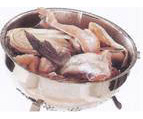
1 Rinse 11/2 lb (750 g) trimmings and put them into a large pan. Add 1 quart (1
liter) water and 1 cup (250 ml) dry white wine. Bring to a boil, skimming the surface.
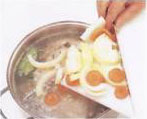
2 Add 1 sliced onion, 1 sliced carrot, 1 chopped celery stalk, 1 bay lea); a few
parsley sprigs, and a few black peppercorns. Simmer for 20-25 minutes. Strain. Use
immediately or cool, cover, and refrigerate. Use within 2 days or freeze for up
to 3 months.
FISH & SHELLFISH KNOW-HOW
SEAFOOD IS ONE OF THE MOST delicious, versatile, and nutritious foods we can eat.
Compared with other protein foods it is an excellent value - usually there is very
little waste - and it is easy to prepare and quick to cook. Fish and shellfish are
good sources of essential nutrients, but oily fish are particularly rich in vitamins
A and D and should be a regular part of a healthy diet.
Seafood is divided into two broad categories: fish and shellfish. Fish can be subdivided
into "round whitefish," such as cod or snapper; "flat whitefish," like flounder
and turbot; and "oily fish," which includes herring and mackerel. All of these are
vertebrates with fins and gills. Among shellfish, crab, shrimp, and mussels have
shells on the outside, while squid have reduced internal shells.
BUYING & STORING
When choosing fish and shellfish, smell and appearance are your guides. Fresh saltwater
fish should smell like the sea. If the fish smells at all unpleasant or ammonialike,
it is not fresh. Whole fresh fish should have clean red gills, shiny scales, and
should feel firm and elastic. The flesh of fillets and steaks should look moist
and lustrous. If buying prepackaged fish, check the color of any liquid that has
accumulated in the pack: it should not be cloudy or off-white.
Shellfish is sold both in the shell and shelled, raw and cooked. The shells of crabs,
lobsters, and shrimp become pink or red when cooked. Live shellfish, such as mussels,
clams, and oysters should have tightly closed shells. Open shells should close if
tapped lightly; if they do not, the shellfish is dead and should be discarded. Shelled
oysters, scallops, and clams should be plump; scallops should smell slightly sweet.
Shrimp should also smell faintly sweet and feel firm.
Keep the fish or shellfish cool until you get home, then unwrap it, cover with a
wet cloth or wet paper towels, and store in the coldest part of the refrigerator.
Use the same day or within 1 day at the most.
Microwaving
Fish and shellfish cook well in a microwave, retaining their texture, flavor, and
juices. But care must be taken not to overcook the delicate flesh. Whether cooking
or thawing, arrange pieces of fish so that the thicker areas are at the outside
of the dish; overlap thin areas or fold them under. With whole fish, shield delicate
areas, such as the tail and head, with smooth strips of foil. If thawing seafood,
again protect thin, delicate areas by shielding them with smooth strips of
|
|
Freezing
It's best to buy fish already frozen, since it is frozen very soon after catching
- often while still at sea - and won't have begun to deteriorate. Some fresh seafood,
particularly shrimp, may already have been frozen, then thawed, so it should not
be refrozen.
Clean fish before freezing, wrap tightly, and, for the best flavor, store for no
longer than 2 months. Fish can be cooked very successfully from frozen but if you
need to thaw it, do so slowly in the refrigerator or quickly in the microwave.
|
Scaling
Unless the fish is to be skinned, remove the scales before cooking. Dip your fingers
in salt to ensure a firm grip and grasp the fish tail. Using the blunt side of a
knife, with firm strokes scrape off the scales from the tail to the head. Rinse
the fish well under cold running water.
CLEANING & FILLETING ROUND FISH
Fish stores will clean and fillet fish for you, but if you have to do it yourself,
here s how. Round fish such as trout, mackerel, herring, or even salmon, are often
cooked whole, and boning makes them easier to serve and eat.
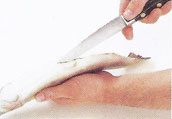
1 Snip off the fins. Cut along the belly, from the vent end to just below the head.
Remove the innards, scraping away any dark blood. Lift the gill covering and remove
the accordion- shaped gills. Rinse well.
|
|
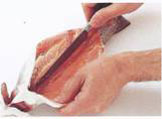
2 Extend the belly opening so that it goes all the way to the tail. Hold the belly
open and carefully run the knife between the flesh and the bones along one side,
from tail to head, to cut the flesh from the rib cage.
|
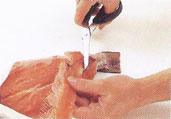
3 Turn the fish around and cut the flesh from the rib cage on the other side. Snip
through the backbone at each end and gently pull it away from the flesh, removing
it with the rib cage in one piece.
|
|
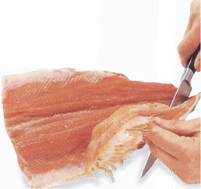
4 If the head and tail have been cut off, open out the fish and lay it skin side
up. Press along the backbone to loosen the bones. Turn over and lift out the rib
cage and backbone, freeing it with a knife if necessary.
|
SKINNING A FLATFISH
A flatfish may be skinned before filleting.
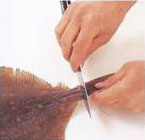
1 With the dark side up, make a shallow cut between the tail and the body. Gently
cut a little of the skin from the flesh.
|
|
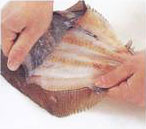
2 Holding the tail with one hand, grip the skin with salted fingers and pull it
away. Repeat on the other side.
|
FILLETING FLATFISH
Either 2 or 4 fillets may be cut from a small flatfish, depending on whether you
would like 2 wide or 4 narrow fillets. Larger flatfish yield 4 fillets.
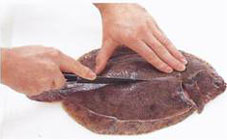
1 Make a shallow cut around the edge of the fish, where the fin bones meet the body.
Cut across the tail and make a curved cut around the head. Cut along the center
of the fish, cutting through to the bone.
|
|
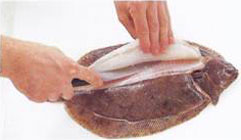
2 Insert the knife between the flesh and the bones at the head end, keeping it almost
parallel to the fish. Cut, close to the bones, to remove the flesh.
|
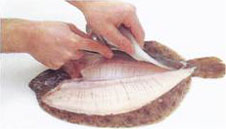
3 Continue cutting, to detach the flesh in one piece. Repeat to remove the second
fillet. Turn the fish over and remove the fillets on the other side in the same
way. Check the flesh for any stray bones.
|
|
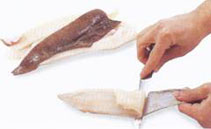
4 To skin, lay each fillet skin side down, hold the tail with salted fingers to
ensure a firm grip, and pull away. Cut through the flesh at the tail end, then hold
the knife at an angle and cut the flesh from the skin.
|
PREPARING SHRIMP
Both cooked and uncooked shrimp can be used successfully in a variety of tasty dishes.
One lb (500 g) of shrimp with shells but no heads will give you about 3/4 lb (375
g) peeled and cooked shrimp.
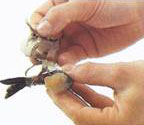
1 Gently pull off the head and then the legs. Peel the shell from the body, starting
at the head end. When you reach the tail, pull it out of the shell.
|
|
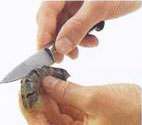
2 Make a shallow cut along the cen ter of the back of the shrimp. Lift out the black
intestinal vein and rinse the shrimp under cold running water.
|
PREPARING MUSSELS & CLAMS
Most mussels and clams are sold live and are cooked by steaming in their shells.
They must be scrubbed before cooking. The anchoring threadsfound on mussels, known
as beards, must also be removed.
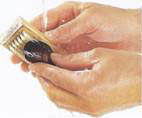
1 To clean the shells of mussels and clams, hold under cold running water and scrub
with a small stiff brush. Use a small knife to scrape off any barnacles.
|
|
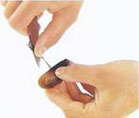
2 To remove the beard from a mussel, hold the beard firmly between your thumb and
the blade of a small knife and pull the beard away from the shell.
|
PREPARING A COOKED CRAB
The lump crabmeat from inside the crab 5 body is highly prized, but the meat from
the legs and claws is also flavorful.
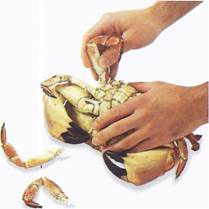
1 Put the crab on its back and twist off the legs and claws, close to the body.
|
|
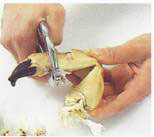
2 Using nutcrackers, a small hammer, or a rolling pin, crack the shells of the claws
without crushing them. Break open the shells and carefully remove the meat, using
a small fork or skewer.
|
|
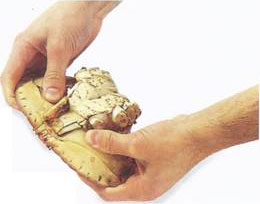
3 Press your thumbs along the "perforation" to crack the central section of the
shell and pry it apart. Remove and discard the "apron" flap from the underside of
the body.
|
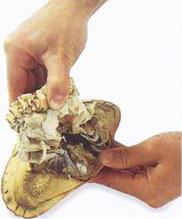
4 Pull the central body section up and away from the shell. Scoop the creamy-textured
brown meat out of the shell and put it into a bowl (keeping it entirely separate
from the white claw and leg meat). Scoop out any roe. Discard the stomach sac, which
is located between the eyes.
|
|
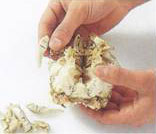
5 Pull the spongy gills (known as "dead man's fingers") from the body and discard
them.
|
|
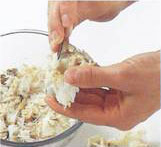
6 Cut the body in half with a large knife and pick out all the meat from the crevices.
Add to the meat in the bowl.
|
PREPARING A COOKED LOBSTER
Cooked lobster can be added to cooked dishes or served cold with mayonnaise, in
which case the shell is simply cut into 2 halves and the flesh loosened and returned
to the shell.
Removing the meat
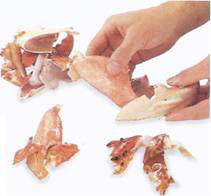
1 Twist off the large claws. Using a strong nutcracker, small hammer, or rolling
pin, crack the shells of the claws without crushing them. Pick out the meat in 1
or 2 large pieces. If the shell is not to be used for serving, pull apart the body
and tail. Twist off the small legs and remove the meat with a skewer or lobster
pick.
|
|
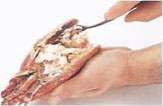
2 Lift off the top of the body shell, scoop out the gray- green liver (tomalley)
and any coral-colored roe, both of which are edible, and reserve. Discard the stomach
and spongy gills ("dead man's fingers").
|
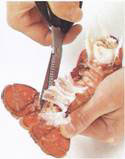
3 With scissors or a sharp knife, cut along the soft underside of the tail.
|
|
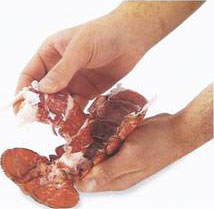
4 Bend back the flaps and carefully remove the tail meat, keeping it in 1 piece.
Remove and discard the intestine that runs through the center of the tail meat.
Slice the tail meat or prepare as required and serve with the claw and leg meat.
|
To serve in the shell
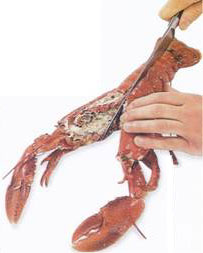
1 Use a knife to cut the lobster in half lengthwise, cutting from the head to the
tail. Keep the shell for serving.
|
|
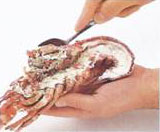
2 Scoop out the liver and roe and discard the intestine. Twist off the legs and
claws and remove the meat. Loosen the tail meat.
|
PREPARING OYSTERS
To shuck oysters, use an oyster knife or a small, strong knife.
Hold oyster round side down and insert the knife near the hinge. Lever the shells
apart. Slide in the knife to sever the top muscle. Lift off the shell. Run the knife
under the oyster to loosen.
PREPARING A SQUID
Once cleaned, fresh squid yields an empty, tubelike body and separate tentacles.
The body may be stuffed before cooking, or sliced and cooked with the tentacles.
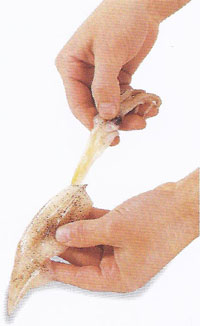
1 Pull the body of the squid away from the head and tentacles. The innards will
come away with the head. Cut off the tentacles just in front of the eyes.
|
|
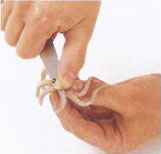
2 Squeeze the tentacles near the cut end to remove the hard beak and then discard
it. Rinse the tentacles well and set aside. Discard the head and innards.
|
|
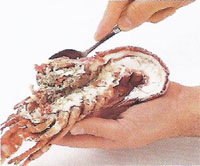
3 Peel the skin from the body. Pull the quill out of the body and discard. Rinse
the body thoroughly, dislodging any remaining innards with your fingers.
|
|



